"It is a mistake to look too far ahead. Only one link in the chain of destiny can be handled at a time." -Winston Churchill
And yet, when you look out, you can't help but wonder how far away these points of light in the sky are.
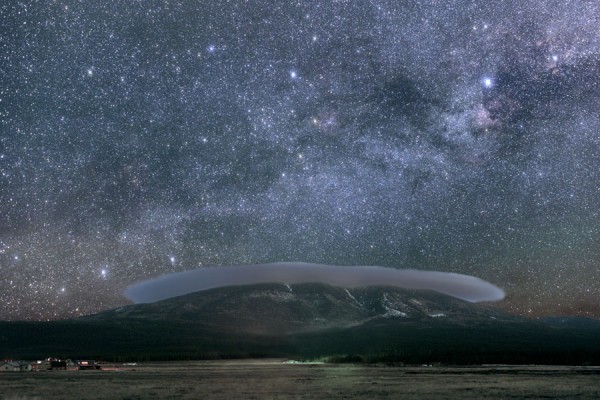
Some things are easy. Our Solar System, for instance. Just by knowing Newton's Laws of gravity and observing the positions of the planets over time, we can determine the distances to any of the planets, our Moon, or our Sun to incredible (better than 99.999%) accuracy.
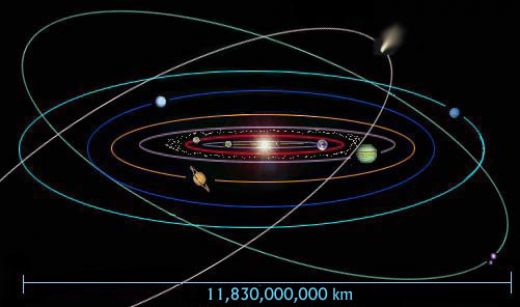
But what about the stars? They're much, much farther away than anything in our Solar System, and they can be awfully deceptive. After all, take a look at these two famous stars from the Southern Hemisphere: alpha centauri and beta centauri!
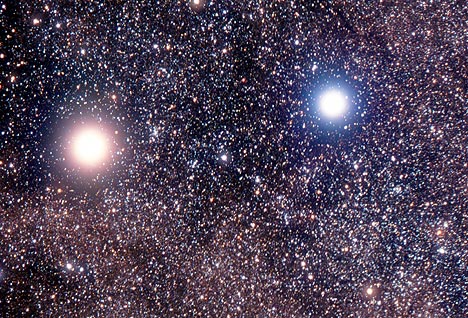
Alpha Centauri is one of the closest stars to us, at a distance of only 4.37 light years. There's a very small uncertainty on that, too. Why? Because it's close enough to measure by the most reliable method of all: parallax!
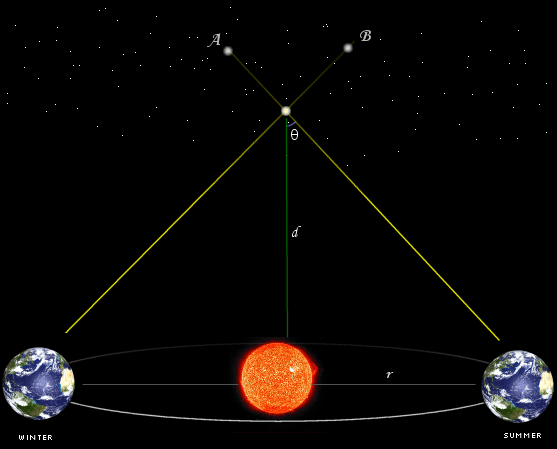
As the Earth orbits the Sun, its position changes by about 300,000,000 km over the span of six months, as we move to the other side of the Sun. While most objects in the sky are very, very far away, the closer ones will appear to change position by a very small (but measurable) amount. The angle the position appears to change by corresponds directly to the distance an object is away from you.
(And you can read a further explanation here.)
But what about that star almost as bright, that's very close to it: Beta Centauri?
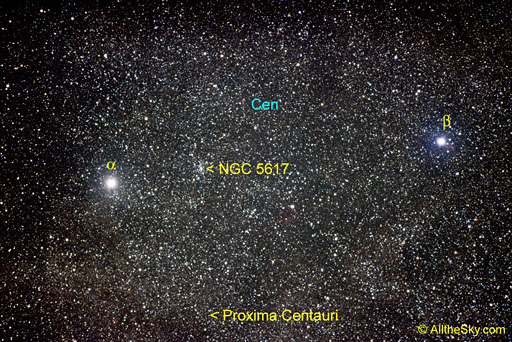
Beta Centauri is very, very strange! Yes, it's blue, but there are actually two stars there. Moreover, they're both blue giants! And what's more, is that Beta Centauri is about 350 light years away!
But when something's too far away to measure a parallax well, we really get stuck! We can't measure a distance directly; we have to estimate it. And the more interesting (and unique) an object is, the harder it is to figure out its distance!
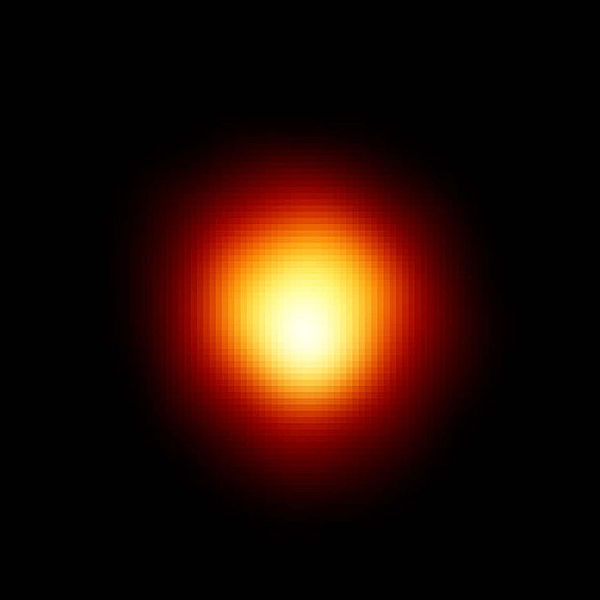
Take Betelgeuse, for instance. Distance estimates range from 180 to 900 light years, a 400% difference!
And what's more, is if you use two different methods of estimating the distance to Betelgeuse, you'd get two different distances! In other words, astronomical distances are easy to get right in terms of a "ballpark" figure, but to get it exactly right with complete confidence is a very, very rare thing. Why? Because the estimates we can come up with are only true on average. In reality, there's a lot of natural variation in these objects.

It's kind of like looking at a picture of a human, "knowing" that humans are six feet tall, and then figuring out how far away that human is. Only, of course, not all humans are six feet tall!
This same problem for stars and humans affect even entire galaxies!
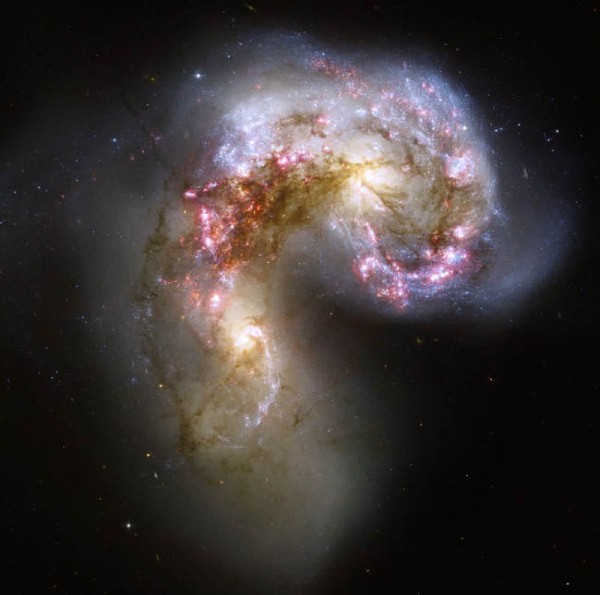
Which brings me to a spectacular pair of galaxies: The Antennae Galaxies, known as NGC 4038 and NGC 4039. These are two of the closest merging galaxies we have, at a distance of just 45 million light years. But if you had asked me their distance 10 years ago, I would've told you 65 million light years!
Why, as ESPN's Gregg Easterbrook notes, were we off by so much?
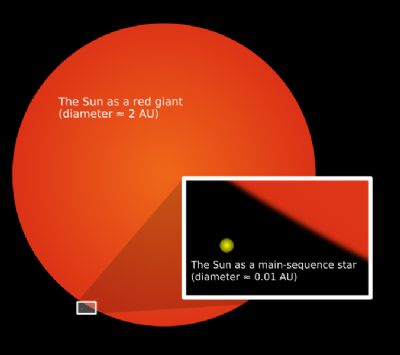
Because the only reliable way to measure the distance to a galaxy is to look at the individual stars in it, measure their brightness, and figure out (based on the brightness of identical, known stars) how far away they are. Only with the new camera on the Hubble Space Telescope were we able to do that for the first time!
In other words, that old 65 million light-year estimate had a huge uncertainty!
It turns out that many of our great astronomical measurements have huge uncertainties, and distances are some of the toughest to get right!
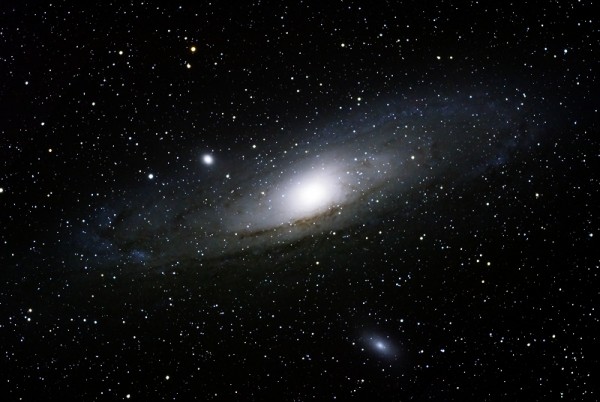
Even Andromeda, the closest big galaxy to us, has undergone a major revision! We used to think it was 500,000 light years away, based on Cepheid stars. Then we discovered a new type of Cepheid, and the distance was suddenly measured in the millions of light years, not the hundred thousands. And -- using the same technique of red giant measurements we just used for the Antennae Galaxies -- we now know that Andromeda is 2.54 million light years away, with an uncertainty of less than 3%.
The moral of the story? Coming up with an estimate is easy. Coming up with an accurate estimate, where you understand and are honest about your uncertainties, is much, much more difficult.
Want to start some trouble along these lines? Ask an astronomer how many stars there are in the Milky Way galaxy...

Astrophysicists are always wrong, but never in doubt. ... RP Kirshner
As Hubble said in The Realm of the Nebulae, âWe measure shadows, and we search among ghostly errors of measurement for landmarks that are scarcely more substantial. The search will continueâ.
âWhat actually happens is that once scientists get hold of a good concept they gradually refine and extend it with greater and greater subtlety as their instruments of measurement improve. Theories are not so much wrong as incomplete.â - Isaac Asimov
"If I am the wisest man," said Socrates, "it is because I alone know that I know nothing."
Not only is the universe stranger than we imagine, it is stranger than we can imagine. - Sir Arthur Eddington
The study of the heavens must from time to time rate with the most humbling of professions. When all else fails, always remember that "Mother Nature's a bitch!"
I have heard the Milky Way contains about 100-400 billion stars.
How do you control for the fact that in the time it takes the Earth to move round the Sun, the star you're looking at has moved in space also?
It's so great to see a science blogger not only dedicated to science but dedicated to blogging science - and more importantly from my perspective dedicated to educating us lay people about the subject you obviously love so much. Thank you!
The "light echoes" from supernova explosions reflected off clouds of interstellar gas long after the supernova has disappeared not only lets us record ancient supernovae that have left no visible supernova remnant, but also serves as a tool for distance measurement independent of other means.
For instance the light echo from the 1987 supernova in the Magellanic Cloud nailed down the distance with a precision compareable to the measurements using cepheid variables.
It also inspired the search for other light echoes -a very difficult task- detracting the "noise" of the background light until arcs of light reflected by the interstellar medium became visible.
Incidentally, if you could just afford to wait long enough, you could map the distribution of otherwise invisible interstellar clouds in the Milky Way by recording how light from supernovae gradually sweep through for tens of thousands of years.
God's story
God created 432 trillion humans and 60 trillion stars (or star-like heavenly bodies) over 40 million billion years ago. The goal of the creation was to achieve higher harmony.
To achieve Trinity (as mentioned by Jesus), God and all other gods (except eleven gods mentioned below) were born into this Earth for many times. They did not go about telling people they were gods. Many times they themselves did not know they were gods on Earth.
God spent trillions of years for achieving Trinity. About 30 years ago, Trinity was achieved. So, the Heaven has been full of joy. With Trinity, God's punishments are much swifter than before. Another benefit of Trinity is that human sins can be seen by sinners and others in public places rather than hidden from the public. Before Trinity, sins were often covered up in public places.
People cannot distinguish God (the Creator of Heaven and this physical universe) from the Father of the Creator. In the past when I said God , I sometimes actually meant the Father of God, for the latter was never mentioned in history. Both God and His Father are great. The Father of God has eleven companions who has never been born to any physical world. They are never mentioned in history.
Humans do not know the Father of God when we are awake. But when are asleep, we go to Heaven every night and we know Him. We simply forget what we know in our sleep, just as we forget our lives in Heaven (before we were born). Trust me, every devil knows who is the Father of God.
When we go to sleep every night, we go to Heaven to drink energy
provided by God. That's the normal condition, but some people go to their friends in hell and drink the energy of God in hell. All humans, no matter in hell or on heaven or in this universe, need the energy of God every so often. This point is obvious to every person in hell or on Heaven. But many people there, as on Earth, are still ungrateful to God most of the time.
The souls of other animals do not need to go back to Heaven to drink God's energy. That's why other animals are more alert in sleep than humans in sleep. That's why humans die within 7 to 8 days if they do not go back to Heaven/Hell to drink God's energy in 7 or 8 days. That's why we feel energetic in the morning even though we may not yet have breakfast in the morning.
Wretch[ed] Fossil,
If you drinking "heaven juice" every night when you sleep... then I assume your probably being sexually assaulted in some sort of fashion. And I also assume this person is very religious as well...
If your making some sort of joke/comparison of the energy of the universe as "god energy" your still wrong as your energy is derived from the matter of earth... Don't believe me?? I challenge you to a "drink gods energy ONLY" challenge...just drink "god juice" and nothing else...I give you about 4-6 days...if you cheat and drink water I give you 2-3 weeks...enjoy
Ethan, nice explanation.
Don't be defensive about the quality of the best data available; we're glad to have it.
All you professional astronomers, Thank you very much.
How long does it take to make these estimations of distance in light years? Since there is so much math involved, do you use a computer to do calculate it, do you do it yourself? And It is incredible how much technology has changed since just ten years ago.
Wait, right after this post you have a post on the most distant galaxy. How is that even accurate?
And by 'those of you', I would presume that not to include good looking girls at bars? "Hey baby, you into redshifts?"
I'm thinking it would be more effective if you just asked her if she wanted to see a picture of your giant 8.6 shifty red thing...
Note to Black males friends: DO NOT attempt this tactic in a college library with an uptight Baptist country girl...and then run for office.
Enjoy.
On the other hand...
Somewhere on the planet....
The following conversation is taking place:
Alright Bill, tell us about your new girlfriend.
Bill: Her name is Sarah. We met in advanced astrophysics at UCB. I asked her to Starbucks after class one day and we got so lost in our conversations on redshifts I just knew she was 'the one'.
Enjoy.
Waydude,
The accuracy on this is actually pretty good, thanks to the spectroscopic measurement of redshift. The redshift 8.6 is pretty certain.
Given that, there's only about an 8% uncertainty in determining its age/distance, which means it's 600 million years into the age of the Universe, plus or minus only about 50 million years.
This blog is fascinating. You explained the difference between an estimate and an accurate estimate perfectly. Basically making an accurate estimate isnât easy and it seems like this is a complicated topic that one must be very educated on astrophysics to understand, but you did a great job at explaining and comparing topics. The links included throughout also helped the understanding. Thank you for a cool and interesting post.
Thanks Ethan! I work with some really cranky creationists, so I like to be well informed.